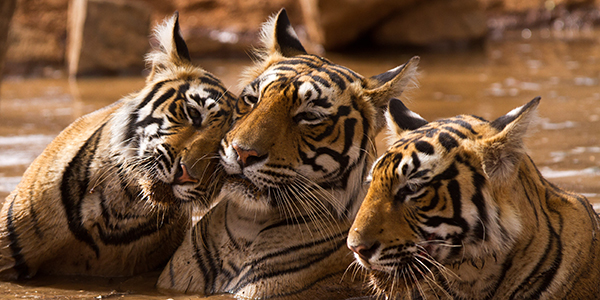Ranthambore: In The Tiger’s Home

A recent Instagram image by Varun Dhawan showed a full-grown tigress lazing about just a few feet from the jeep that the Bollywood star was ostensibly traveling in for a jungle safari.
Riddhi (T124), the daughter of Arrowhead (T84), who lives in the best tiger habitat between the three lakes in the Ranthambore Tiger Reserve in Rajasthan, is the star of Varun’s Instagram video. Many people believe the Ranthambore reserve to be the greatest in India for finding and photographing royal Bengal tigers because of the dry deciduous and thorny forests that create a distinctive scenery there. Every year, hundreds of people—from ordinary people to celebrities to wildlife experts—visit this home of the big cats.
In order to distinguish the tigers from other species, they are given identification numbers here as well as in the other reserves that begin with the letter “T.” This facilitates the identification, tracking, and gathering of crucial information regarding their behavior, habitat use, and mobility.
Riddhi, one of the young adult tigresses of Ranthambore, is frequently observed in zones 3 and 4. She has previously engaged in multiple territorial battles with her sister Siddhi. Riddhi was recently captured on camera mating with Ganesh, a young adult male tiger. I was taken aback and alarmed by that video because just a few days prior, Riddhi had been briefly seen cuddling cubs. In the rainforests, there is a common notion that a tigress mating soon after giving birth indicates that the cubs have passed away. For other felids, the same is true.

Where Machali resided
Tigers are given names that correspond to their look, personality, or other distinctive traits in addition to their T numbers. A prime example is Machali, also known as T16 or the Ranthambore Tiger Queen, who was given her given name in honor of a fish-shaped marking on her face. Machali, who was 19 years old and was thought to be the tiger that had been photographed the most worldwide, passed away in August 2016. Tigers typically live until 15 or 16. A National Geographic article states that visitors who came to observe Machali brought in about $10 million USD annually to the reserve.
Five safari zones were initially present in the Ranthambore reserve, and five more were eventually added. Although Zones 1 to 5 are said to be the best for seeing tigers, Zones 6 to 10 also have a good chance of doing so. There have been numerous reports of sightings in Zone 10 during the previous two months. Each zone has distinct features, vantage points, and animals, including tigers, leopards, and various birds. Zone 2, which has many waterholes, is particularly noteworthy because of the volume of observations there.
Starting in October 2022, the reserve administration will enforce a strict zone-permit restriction that forbids guides from communicating walkie-talkie reports of tiger sightings to other guides. They risk losing their jobs for transgressions.

In the past, these tip-offs would cause visitors to race in their cars across zones to the location of the sighting. Due to the new “no free zone” and “no full day” permit requirements, during a safari, the vehicles must stay inside a specific zone and cannot stay in the park for an extended amount of time. In my experience, these regulations are not only in place but also strictly followed. Therefore, to significantly increase your chances of sighting the gorgeous big cats in the wild, do your research on the zones before traveling to Ranthambore.
News Mania Desk






